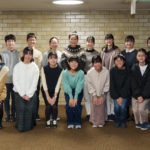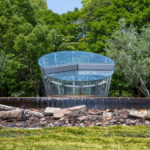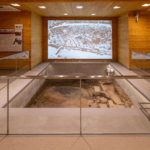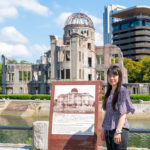I The Chugoku Shimbun before the War and after the Atomic Bombing
As a local Hiroshima newspaper founded on May 5, 1892, the Chugoku Shimbun has played a major role in covering news of the atomic bombing and peace.1) It was originally issued daily as “The Chugoku,” but when it reached its 5,000th issue in 1908, the newspaper changed its name to “The Chugoku Shimbun,” which it has retained to this day.
Due to the reduction in paper rations for newsprint during the Second Sino-Japanese War, formerly 14 pages of the newspaper (including morning and evening editions) shifted to 12 pages (eight pages for the morning edition and four pages for the evening edition). Even afterwards, the number of pages continued to shrink. The evening edition of the Chugoku Shimbun was discontinued in March 1944 as newspapers across the country discontinued their evening papers. Starting in November of that year, the morning paper shrunk to two pages, or 14 pages a week. With regard to the paper’s circulation, in 1916 it was said to have been 40,000 copies (the actual number was about 35,000 copies), but it doubled to 107,000 copies by December 1941. With the war and its expanding theaters of operation, war correspondents and photographers were dispatched to war zones, and the Chugoku Shimbun aggressively covered the war. Through these efforts, the Chugoku Shimbun expanded its circulation and became an “area newspaper” for the wider area of the Chugoku District. The sales network included not only Hiroshima, in which the head office was located, but also Iwakuni and Yanai, which are within Hiroshima’s economic sphere, and Tokuyama, Hofu and other areas in Yamaguchi Prefecture.
There were about 1,200 newspaper companies nationwide around 1936, but they were consolidated under the policy of the national government and the Ministry of Home Affairs that stipulated “one newspaper company per prefecture.” By October 1942, they were consolidated into 54 newspapers; and by April 1944, the Chugoku Shimbun was Hiroshima Prefecture’s only newspaper. Its circulation reached 380,000, and its reporters gathered news and wrote articles under restrictions on the freedom of speech and pre-censorship during the war.
The atomic bomb dropped by the American bomber Enola Gay on August 6, 1945 exploded almost directory above the employees of the Chugoku Shimbun as well. More than 100 employees instantly lost their lives while on their way to work or in the head office building (900 meters from the hypocenter). The following is an account from an employee who was in the office building. “All the glass windows shattered as the bomb exploded, and the exterior tiles on the new building were ripped off and scattered in all directions. One employee was blown from the second floor by the bomb blast. It became momentarily pitch dark from the dust and flying debris. Soon it seemed that the chemicals in the storage on the fourth floor had caught fire, and burning debris falling down the walls lit up the area.” 2)
Many of the surviving employees had suffered various degrees of injuries. Directly after the bomb, the Chugoku Shimbun building was totally burned out, including the rotary presses and other facilities, leaving only the exterior walls. However, one rotary press and its associated equipment had been evacuated to Nukushina in the eastern part of the city. This press played an important role in restarting operations.
The Chugoku Shimbun and its employees suffered catastrophic damages, just like the citizens of Hiroshima. As this media organization based in an A-bombed city, the Chugoku Shimbun faced this great adversity and looked for ways to overcome its hardship.
(Seiichi Koike)
Notes and References
1. The following accounts are mainly based on Seiichi Koike’s “Hiroshima ni Okeru Media no ‘Sengo’ – Chugoku Shimbun, Chugoku Shimbunsha o Chushin ni” (“Postwar” for the media in Hiroshima – Focused on the Chugoku Shimbun newspaper and the Chugoku Shimbun Company): Koike, Seiichi (Ed.). “Hibakuchi Hiroshima no Fukko Katei ni Okeru Shimbunjin to Hodo ni Kansuru Chosa Kenkyu” (Research study into newspaper journalists and press in the reconstruction process of Hiroshima, an atomic bombed city). Heisei Jukyu Nendo, Zaidanhojin Mitsubishi Zaidan Jinbun Kagaku Kenkyu Josei Kenkyu Hokokusho, March 2009.
2. Chugoku Shimbun Shashi Hensan Iinkai (Ed.). Chugoku Shimbun Hachiju Nenshi (Eighty Years’ History of the Chugoku Shimbun). Chugoku Shimbun: 1972, p. 158.
– Koike, Seiichi. “Hiroshima ni Okeru Media no ‘Sengo’ – Chugoku Shimbun, Chugoku Shimbunsha o Chushin ni” (“Postwar” for the media in Hiroshima – Focused on the Chugoku Shimbun newspaper and the Chugoku Shimbun Company): Koike, Seiichi (Ed.). “Hibakuchi Hiroshima no Fukko Katei ni Okeru Shimbunjin to Hodo ni Kansuru Chosa Kenkyu” (Research study into newspaper journalists and press in the reconstruction process of Hiroshima, an atomic bombed city). Heisei Jukyu Nendo, Zaidanhojin Mitsubishi Zaidan Jinbun Kagaku Kenkyu Josei Kenkyu Hokokusho, March 2009.
– Chugoku Shimbun Shashi Hensan Iinkai (Ed.). Chugoku Shimbun Hachiju Nenshi (Eighty Years’ History of the Chugoku Shimbun). Chugoku Shimbun: 1972.
Tags associated with this article








